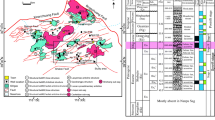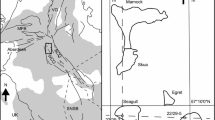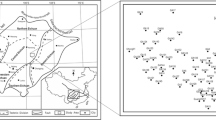Abstract
The heterogeneity of depositional and diagenetic controls on the reservoir quality of tight sandstones is a major challenge. Understanding which factors are the most influential is significant for improving reservoir evaluation and prediction. This study utilized sedimentological core descriptions, thin-section petrography, quantitative evaluation of mineralogy by scanning electron microscope, X-ray diffractometry, scanning electron microscopy and porosity–permeability measurements to define and characterize the factors that control reservoir quality in the Upper Ordovician Sarah Formation of the Rub’ al Khali Basin. Four facies associations (FA), including fluvial (FA1), glaciolacustrine delta (FA2), subglacial (FA3) and glaciofluvial (FA4), have been recognized. The results show that the highest reservoir quality was enhanced by feldspar dissolution in FA1. The development of its reservoir quality was, however, partially limited by compaction, and authigenic pore filling and grain coating with the clay mineral, illite. The lowest reservoir quality, related to FA3, appears to have been influenced by the detrital matrix content, compressibility and siderite cement precipitation. The presence of a detrital matrix, anhydrite and barite cement, and grain compaction reduced the reservoir quality in FA2. On the other hand, intergranular porosity, and fractures that facilitated the development of dual porosity and permeability systems in this FA, might have slightly enhanced its reservoir quality. Factors such as grain-size distribution and sorting influenced the reservoir quality of all the FAs, but these were the main controls on the reservoir quality of FA4, in addition to compaction. The reservoir quality of this FA might have also been improved by fractures and the dissolution of unstable grains.














Similar content being viewed by others
References
Holditch, S.A.: Tight gas sands. J. Pet. Technol. 58, 86–93 (2006)
Jiang, Z.X.; Li, Z.; Li, F.; Pang, X.Q.; Yang, W.; Liu, L.F.; Jiang, F.J.: Tight sandstone gas accumulation mechanism and development models. Pet. Sci. 12, 587–605 (2015). https://doi.org/10.1007/s12182-015-0061-6
Hayton, S.; Heine, C.; Gratto, B.E.: Tight gas exploration in Saudi Arabia. In: SPE Deep Gas Conference and Exhibition. Society of Petroleum Engineers (2010)
Lai, J.; Wang, G.; Wang, Z.; Chen, J.; Pang, X.; Wang, S.; Zhou, Z.; He, Z.; Qin, Z.; Fan, X.: A review on pore structure characterization in tight sandstones. Earth Sci. 177, 436–457 (2018). https://doi.org/10.1016/j.earscirev.2017.12.003
Sahin, A.: Unconventional natural gas potential in Saudi Arabia. In: SPE Middle East Oil and Gas Show and Conference. Society of Petroleum Engineers (2013)
Al-Mahmoud, M.J.; Al-Ghamdi, I.: An overview of tight gas reservoirs in Saudi Arabia. In: Second EAGE Middle East Tight Gas Reservoirs Workshop. EAGE (2010)
British Petroleum: BP statistical review of world energy 2017 (2017)
Gier, S.; Worden, R.H.; Johns, W.D.; Kurzweil, H.: Diagenesis and reservoir quality of Miocene sandstones in the Vienna Basin, Austria. Mar. Pet. Geol. 25, 681–695 (2008). https://doi.org/10.1016/j.marpetgeo.2008.06.001
Zhang, Y.; Pe-Piper, G.; Piper, D.J.W.: How sandstone porosity and permeability vary with diagenetic minerals in the Scotian Basin, offshore eastern Canada: implications for reservoir quality. Mar. Pet. Geol. 63, 28–45 (2015). https://doi.org/10.1016/j.marpetgeo.2015.02.007
Alqubalee, A.; Abdullatif, O.; Babalola, L.; Makkawi, M.: Characteristics of Paleozoic tight gas sandstone reservoir: integration of lithofacies, paleoenvironments, and spectral gamma-ray analyses, Rub’ al Khali Basin, Saudi Arabia. Arab. J. Geosci. (2019). https://doi.org/10.1007/s12517-019-4467-0
Konert, G.; Afifi, A.M.; Al-Hajri, S.A.; Droste, H.J.: Paleozoic stratigraphy and hydrocarbon habitat of the Arabian plate. GeoArabia 6, 407–442 (2001). https://doi.org/10.1306/M74775C24
Stoeser, D.B.; Camp, V.E.: Pan-African microplate accretion of the Arabian Shield. Bull. Geol. Soc. Am. 96, 817–826 (1985). https://doi.org/10.1130/0016-7606
Stewart, S.A.: Structural geology of the Rub’ Al-Khali Basin, Saudi Arabia. Tectonics 35, 2417–2438 (2016). https://doi.org/10.1002/2016TC004212
Stern, R.J.; Johnson, P.: Continental lithosphere of the Arabian Plate: a geologic, petrologic, and geophysical synthesis. Earth-Sci. Rev. 101, 29–67 (2010). https://doi.org/10.1016/j.earscirev.2010.01.002
Dyer, R.A.; Husseini, M.: The western Rub’Al-Khali Infracambrian Graben System. In: Middle East Oil Show. Society of Petroleum Engineers, Bahrain (1991)
Vaslet, D.: Upper ordovician glacial deposits in Saudi-Arabia. Episodes 13, 147–161 (1990)
McClure, H.A.: Early paleozoic glaciation in Arabia. Palaeogeogr. Palaeoclimatol. Palaeoecol. 25, 315–326 (1978)
Vaslet, D.; Kellogg, K.S.; Berthiaux, A.; Le Strat, P.; Vincent, P.L.: Explanatory notes to the geologic map of the Baq’a Quadrangle, Kingdom of Saudi Arabia. Geosci. Map GM-116 C, Scale 1250,000. 1–45 (1987)
Williams, P.L.; Vaslet, D.; Johnson, P.R.; Berthiaux, A.; Le Strat, P.; Foumiguet, J.: Geologic map of the Jabal Habashi quadrangle, sheet 26F. Kingdom Saudi Arab. Saudi Arab. Deputy Minist. Miner. Resour. Geosci. Map-GM-98 A, Scale 1250,000 (1986)
Clark-Lowes, D.D.: Sedimentology and mineralization potential of Saq and Tabuk formations. Imp. Coll. Sci. Technol. London, Open-File Rep. CRC/IC. 7 (1980)
SSC.: Phanerozoic Stratigraphy of Saudi Arabia Part 1. In: Saudi Geological Survey. Special Publications, 1st edn, pp 1–69 (2013)
Abu-Ali, M.; Littke, R.: Paleozoic petroleum systems of Saudi Arabia: a basin modeling approach. GeoArabia 10, 131–168 (2005)
Senalp, M.; Al-Laboun, A.: New evidence on the Late Ordovician glaciation in central Saudi Arabia. Saudi Aramco J. Technol. Spring. 14, 11–40 (2000)
Tofaif, S.; Le Heron, D.P.; Melvin, J.: Development of a palaeovalley complex on a Late Ordovician glaciated margin in NW Saudi Arabia. Geol. Soc. London Spec. Publ. 475, 81–107 (2018). https://doi.org/10.1144/sp475.8
Clark-Lowes, D.D.: Arabian glacial deposits: recognition of palaeovalleys within the Upper Ordovician Sarah Formation, Al Qasim district, Saudi Arabia. Proc. Geol. Assoc. 116, 331–347 (2005). https://doi.org/10.1016/S0016-7878(05)80051-3
El-Deek, I.; Abdullatif, O.; Korvin, G.: Heterogeneity analysis of reservoir porosity and permeability in the Late Ordovician glacio-fluvial Sarah Formation paleovalleys, central Saudi Arabia. Arab. J. Geosci. 10, 400 (2017). https://doi.org/10.1007/s12517-017-3146-2
Babiker, J.M.A.; Hariri, M.M.; Abdullatif, O.; Korvin, G.: Types and nature of fracture associated with Late Ordovician paleochannels of glaciofluvial Sarah Formation, Qasim region. Central Saudi Arabia. Arab. J. Geosci. 10, 146 (2017). https://doi.org/10.1007/s12517-017-2922-3
Craigie, N.W.; Rees, A.; MacPherson, K.; Berman, S.: Chemostratigraphy of the Ordovician Sarah Formation, North West Saudi Arabia: an integrated approach to reservoir correlation. Mar. Pet. Geol. 77, 1056–1080 (2016). https://doi.org/10.1016/j.marpetgeo.2016.07.009
Bassis, A.; Hinderer, M.; Meinhold, G.: Petrography and geochemistry of Palaeozoic quartz-rich sandstones from Saudi Arabia: implications for provenance and chemostratigraphy. Arab. J. Geosci. 9, 400 (2016). https://doi.org/10.1007/s12517-016-2412-z
Al-Harbi, O.A.; Khan, M.M.: Source and origin of glacial paleovalley-fill sediments (Upper Ordovician) of Sarah Formation in central Saudi Arabia. Arab. J. Geosci. 4, 825–835 (2011)
Bassis, A.; Hinderer, M.; Meinhold, G.: New insights into the provenance of Saudi Arabian Palaeozoic sandstones from heavy mineral analysis and single-grain geochemistry. Sediment. Geol. 333, 100–114 (2016). https://doi.org/10.1016/j.sedgeo.2015.12.009
Moscariello, A.; Spaak, P.; Jourdan, A.; Azzouni, A.-H.: The ordovician glaciation in Saudi Arabia—exploration challenges part 1. Geology (Outcrop, Subsurface, Analogues). In: AAPG International Conference and Exhibition,. Search and Discovery Article #50175 (2008)
Briner, A.P.A.P.; Hulver, M.; Azzouni, A.; Harvey, C.: Regional reservoir quality of a tight gas play: the ordovician Sarah Formation in the Rub’Al Khali Basin of Southern Saudi Arabia. In: Second EAGE Middle East (2010)
Haile, B.G.; Klausen, T.G.; Czarniecka, U.; Xi, K.; Jahren, J.; Hellevang, H.: How are diagenesis and reservoir quality linked to depositional facies? A deltaic succession, Edgeøya. Svalbard. Mar. Pet. Geol. 92, 519–546 (2018). https://doi.org/10.1016/j.marpetgeo.2017.11.019
Bjørlykke, K.: Relationships Between Depositional Environments, Burial History and Rock Properties: Some Principal Aspects of Diagenetic Process in Sedimentary Basins. Elsevier, Amsterdam (2014)
Dewhurst, D.N.; Aplin, A.C.; Sarda, J.-P.; Yang, Y.: Compaction-driven evolution of porosity and permeability in natural mudstones: an experimental study. J. Geophys. Res. Solid Earth. 103, 651–661 (1998). https://doi.org/10.1029/97JB02540
English, K.L.; English, J.M.; Bonnell, L.M.; Lander, R.H.; Hollis, C.; Redfern, J.; Guirdham, C.; Garnham, J.; Yahia Cherif, R.: Controls on reservoir quality in exhumed basins—an example from the Ordovician sandstone, Illizi Basin, Algeria. Mar. Pet. Geol. 80, 203–227 (2017). https://doi.org/10.1016/j.marpetgeo.2016.11.011
Morad, S.; Ketzer, J.M.; DeRos, F.: Spatial and temporal distribution of diagenetic alterations in siliciclastic rocks: implication for mass transfer in sedimentary basins. Sedimentology 47, 95–120 (2000). https://doi.org/10.1046/j.1365-3091.2000.00007.x
Mahmic, O.; Dypvik, H.; Hammer, E.: Diagenetic influence on reservoir quality evolution, examples from Triassic conglomerates/arenites in the Edvard Grieg field, Norwegian North Sea. Mar. Pet. Geol. 93, 247–271 (2018). https://doi.org/10.1016/j.marpetgeo.2018.03.006
Chuhan, F.A.; Kjeldstad, A.; Bjørlykke, K.; Høeg, K.: Experimental compression of loose sands: relevance to porosity reduction during burial in sedimentary basins. Can. Geotech. J. 40, 995–1011 (2003). https://doi.org/10.1139/t03-050
Al-Ramadan, K.: Illitization of Smectite in Sandstones: the Permian Unayzah Reservoir, Saudi Arabia. Arab. J. Sci. Eng. 39, 407–412 (2014). https://doi.org/10.1007/s13369-013-0913-6
Al-Husseini, M.: Update to late triassic-jurassic stratigraphy of Saudi Arabia for the middle east geologic time scale. GeoArabia 14, 145–186 (2009)
Ruban, D.A.; Al-Husseini, M.I.; Iwasaki, Y.: Review of middle east Paleozoic plate tectonics. GeoArabia. 12, 35–56 (2007)
Ziegler, M.: Late Permian to Holocene Paleofacies Evolution of the Arabian Plate and its Hydrocarbon Occurrences. GeoArabia 6, 445–504 (2001)
Acknowledgements
We sincerely acknowledge the support provided by the King Fahd University of Petroleum and Minerals (KFUPM). This work was supported by the King Abdulaziz City for Science and Technology as part of the National Science, Technology, and Innovation Plan (NSTIP Project # 14-OIL468-04) through the Science and Technology Unit at KFUPM. The samples used in this study were provided by the Ministry of Energy, Industry and Mineral Resources, Saudi Arabia. The SEM and XRD analyses were conducted at the Center for Engineering Research (CER), Research Institute, KFUPM. The support of these organizations at every stage of the work is fully acknowledged. The authors also thank Mr. Hatem Mohammed and Mr. Abdul-Rasheed Isiaka, from CER, for their assistance in the SEM and XRD analyses.
Author information
Authors and Affiliations
Corresponding authors
Rights and permissions
About this article
Cite this article
Alqubalee, A., Babalola, L., Abdullatif, O. et al. Factors Controlling Reservoir Quality of a Paleozoic Tight Sandstone, Rub’ al Khali Basin, Saudi Arabia. Arab J Sci Eng 44, 6489–6507 (2019). https://doi.org/10.1007/s13369-019-03885-9
Received:
Accepted:
Published:
Issue Date:
DOI: https://doi.org/10.1007/s13369-019-03885-9




